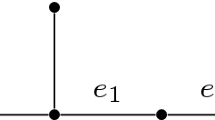Abstract
In recent years there has been increased interest in extremal problems for “counting” parameters of graphs. For example, the Kahn-Zhao theorem gives an upper bound on the number of independent sets in a d-regular graph. In the same spirit, the Upper Matching Conjecture claims an upper bound on the number of k-matchings in a d-regular graph. Here we consider both matchings and matchings of fixed sizes in graphs with a given number of vertices and edges. We prove that the graph with the fewest matchings is either the lex or the colex graph. Similarly, for fixed k, the graph with the fewest k-matchings is either the lex or the colex graph. To prove these results we first prove that the lex bipartite graph has the fewest matchings of all sizes among bipartite graphs with fixed part sizes and a given number of edges.
Similar content being viewed by others
References
R. Ahlswede and G. O. H. Katona: Graphs with maximal number of adjacent pairs of edges, Acta Math. Acad. Sci. Hungar. 32 (1978), 97–120.
N. Alon and S. Friedland: The maximum number of perfect matchings in graphs with a given degree sequence, Electron. J. Combin. 15 (2008), Note 13, 2.
B. Bollobás: Modern graph theory, Graduate Texts in Mathematics, vol. 184, Springer-Verlag, New York, 1998.
W. Cuckler and J. Kahn: Entropy bounds for perfect matchings and Hamiltonian cycles, Combinatorica 29 (2009), 327–335.
J. Cutler and A. J. Radcliffe: An entropy proof of the Kahn-Lovász theorem, Electron. J. Combin. 18 (2011), Paper 10, 9.
J. Cutler and A. J. Radcliffe: Extremal graphs for homomorphisms, J. Graph Theory 67 (2011), 261–284.
J. Cutler and A. J. Radcliffe: Extremal graphs for homomorphismsii, Journal of Graph Theory (2013).
D. Foata and M. P. Schützenberger: On the rook polynomials of Ferrers relations, in: Combinatorial theory and its applications, II (Proc. Colloq., Balatonflured, 1969), North-Holland, Amsterdam, 1970, 413–436.
S. Friedland, E. Krop and K. Markström: On the number of matchings in regular graphs, Electron. J. Combin. 15 (2008), Research Paper 110, 28.
D. Gross, N. Kahl and J. T. Saccoman: Graphs with the maximum or minimum number of 1-factors, Discrete Math. 310 (2010), 687–691.
P. L. Hammer, U. N. Peled and X. Sun: Dierence graphs, Discrete Appl. Math. 28 (1990), 35–44.
J. Kahn: An entropy approach to the hard-core model on bipartite graphs, Combin. Probab. Comput. 10 (2001), 219–237.
N. V. R. Mahadev and U. N. Peled: Threshold graphs and related topics, Annals of Discrete Mathematics, vol. 56, North-Holland Publishing Co., Amsterdam, 1995.
J. Riordan: An introduction to combinatorial analysis, Dover Publications Inc., Mineola, NY, 2002, Reprint of the 1958 original [Wiley, New York].
M. Yannakakis: The complexity of the partial order dimension problem, SIAM J. Algebraic Discrete Methods 3 (1982), 351–358.
Y. Zhao: The number of independent sets in a regular graph, Combin. Probab. Comput. 19 (2010), 315–320.
Author information
Authors and Affiliations
Corresponding author
Rights and permissions
About this article
Cite this article
Keough, L., Radcliffe, A.J. Graphs with the fewest matchings. Combinatorica 36, 703–723 (2016). https://doi.org/10.1007/s00493-014-3188-y
Received:
Revised:
Published:
Issue Date:
DOI: https://doi.org/10.1007/s00493-014-3188-y




